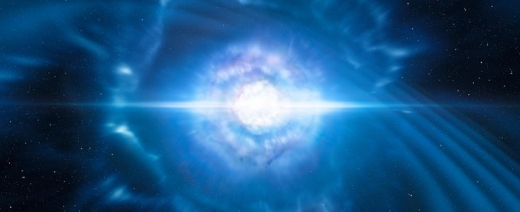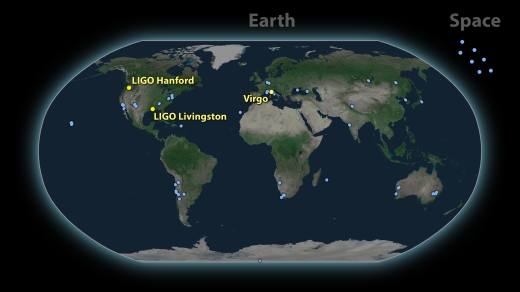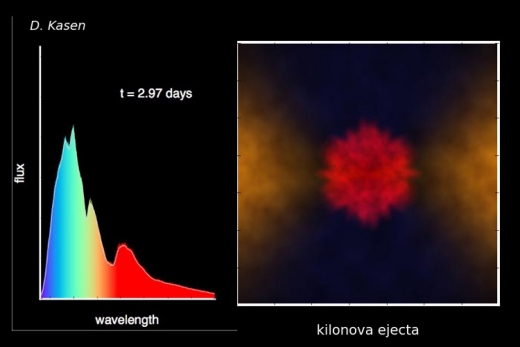I had thought to go straight back into current news after Centauri Dreams‘ recent hiatus, but that’s never a fully satisfactory solution, especially when major events happen while I’m away. I don’t want to simply repeat what everyone has already read about the gravitational wave event GW170817, but there are a few things that caught my eye that we can discuss this morning. After all, we’re dealing with a new phenomenon — kilonovae — that has been predicted but never observed. Nor have we ever before tied gravitational wave events to visible light.

Image: Artist’s impression of merging neutron stars. Credit: ESO.
Now we’re seeing the combination of gravitational wave and electromagnetic astronomy in what promises to be a fertile new ground of study. The fifth GW event ever observed, GW170817 was detected on August 17 of this year by the Laser Interferometer Gravitational-Wave Observatory (LIGO) in the US, working with the Virgo Interferometer in Italy. In less than two seconds, the Fermi Gamma-ray Space Telescope and ESA’s INTErnational Gamma Ray Astrophysics Laboratory (INTEGRAL) detected a gamma ray burst from the same area of sky.
The collaborative nature of the observations that ensued is quite an achievement. What our gravitational wave detectors can give us is a broad window on the sky within which the event can be confined, one that contains millions of stars and is localized to an area of about 35 square degrees. Telescopes searching for the source included ESO’s Visible and Infrared Survey Telescope for Astronomy (VISTA) and VLT Survey Telescope (VST) at the Paranal Observatory, the Italian Rapid Eye Mount (REM) telescope at ESO’s La Silla Observatory, the LCO 0.4-meter telescope at Las Cumbres Observatory, and the American DECam at Cerro Tololo Inter-American Observatory. Pan-STARRS and Subaru in Hawaii quickly joined in.
I won’t keep listing them here, but about 70 observatories around the world went to work on GW170817, with the Swope 1-meter instrument in Chile announcing a new point of light close to the lenticular galaxy NGC 4993 in Hydra, quickly verified by VISTA observations in the infrared. Distance estimates agreed with the 130 million light year distance of NGC 4993, so what we have is the closest gravitational wave event yet detected and a relatively close gamma-ray burst.

Image: A map of the approximately 70 light-based observatories that detected the gravitational-wave event called GW170817. On August 17, the LIGO and Virgo detectors spotted gravitational waves from two colliding neutron stars. Light-based telescopes around the globe observed the aftermath of the collision in the hours, days, and weeks following. They helped pinpoint the location of the neutron stars and identified signs of heavy elements, such as gold, in the collision’s ejected material. Credit: LIGO-Virgo.
This is the first time I have encountered the term ‘kilonova,’ though the idea behind it is decades old. The properties of this event track theoretical predictions that have been used to explain short gamma-ray bursts, events a thousand times brighter than a typical nova. The simultaneous detection of gravitational waves and gamma rays from this source provides powerful evidence. The merger of two neutron stars, thought to be the cause of the event, has produced a burst of heavy elements moving outbound as fast as .20 c.
Each neutron star in the binary that merged weighed between 1 and 2 solar masses, making the detection of their merger tricky because they are so much smaller than the black holes events we have previously observed. Thus Eliot Quataert (UC-Berkeley):
“We were anticipating LIGO finding a neutron star merger in the coming years but to see it so nearby – for astronomers – and so bright in normal light has exceeded all of our wildest expectations. And, even more amazingly, it turns out that most of our predictions of what neutron star mergers would look like as seen by normal telescopes were right!”
Thus we expand our understanding of how heavy elements are created, a process that can happen in stellar cores through fusion up to iron. Just how elements beyond iron are produced has always been a major issue in astrophysics, but neutron star mergers offer a solution. It was evidently Quataert, working with Brian Metzger (Columbia University) and Daniel Kasen (UC-Berkeley) who applied the term ‘kilonova’ to such events in a 2010 paper (see this UC-Berkeley news release). Kasen refers to neutron star merger debris as ‘weird stuff — a mixture of precious metals and radioactive waste.’
And Columbia postdoc Jennifer Barnes, who had worked with Kasen at Berkeley, helped nail down what a kilonova should look like:
“When we calculated the opacities of the elements formed in a neutron star merger, we found a lot of variation. The lighter elements were optically similar to elements found in supernovae, but the heavier atoms were more than a hundred times more opaque than what we’re used to seeing in astrophysical explosions,” said Barnes. “If heavy elements are present in the debris from the merger, their high opacity should give kilonovae a reddish hue.”

Image: A team of UC Santa Cruz astronomers led by former UC Berkeley graduate student Ryan Foley was the first to detect the light from the neutron star merger 11 hours after the gravitational waves from the collision reached Earth. The left image shows that the glow (red arrow) was not there four months earlier. Credit: UC-SC, Swopes Telescope and Hubble.
The observations fit the calculations, with the color of the merger event shading from an earlier blue to the reddish signature showing the heavier elements of the inner debris cloud.

Image: Three days after the merger and explosion, the bright blue glow from lighter elements in the outer polar regions is beginning to fade, giving way to the red glow from the heavier elements in the surrounding doughnut and spherical core. The red glow persisted for more than two weeks. Credit: Dan Kasen.
About 6 percent of a solar mass of heavy elements came out of all this, a yield of gold alone that was more than 200 Earth masses, and a platinum yield of nearly 500 Earth masses. Neutron star mergers, it appears, can account for all the gold in the visible universe. So much for the idea that what we can now call ‘ordinary’ supernovae can account for the heavy elements beyond iron. Clearly, neutron star mergers are a key player. Gravitational wave astronomy is already paying off.
Those wanting to dig into the papers on GW170817 can start with Kasen et al., “Origin of the heavy elements in binary neutron-star mergers from a gravitational-wave event,” Nature 16 October 2017 (abstract), as well as Arcavi et al., “Optical emission from a kilonova following a gravitational-wave-detected neutron-star merger,” Nature 16 October 2017 (abstract) and work from there. The UC-Berkeley news release cited above contains links to a variety of key sources.



Wow. I always though the supernova’s made the gold. This is why gold is so rare not the supernovas. I read that the lighter atoms absorb light more towards the ultra violet and the heavier atoms absorb more towards the infra red. source. Absolutely Small. I can see that idea works through the remote sensing of the elements with electromagnetism. I never heard of the word Kilonova for the collision of neutrons stars also.
To complete the LIGO set we’re now waiting to detect a black hole merger with a neutron star, and the direct detection of waves from a supernova or hypernova. Yet more refined checks on the accuracy of GR will result. Both of these candidates should have optical counterparts and so will put on quite the show.
I still have not heard any explanation for the almost-two-second delay between the merger (as signaled by the gravity waves) and the emission of the gamma rays. Anybody understand this?
I think it’s called the Shapiro Effect. GW’s are unaffected by magnetic fields, and therefore travel in an ABSOLUTE STRAIT LINE, whereas magnetic fields cause EMW’s to corkscrew in an extremely minute way, meaning that the overall DISTANCE the EMW’s travel is very very VERY slightly GREATER than the distance the GW’s travel.
“waiting to detect a black hole merger with a neutron star, and the direct detection of waves from a supernova or hypernova”
The mass ratio between a BH and neutron star is likely to be large, therefore the gravitational wave emission would be weak so the event would have to be close. Supernovae etc. require a great deal of asymmetry to result in any appreciable gravitational waves. And the lower frequency is (as I recall) outside LIGO’s sensitivity range. All of these would be nice to see but don’t hold your breath.
I found the chart I was looking for. It plots amplitude (by detectable strain) and frequency by GW instrument and event class. I had an old copy on my computer but had to do a search to find where it’s from. This provides a better answer than I gave earlier.
https://commons.wikimedia.org/wiki/File:Gravitational-wave_detector_sensitivities_and_astrophysical_gravitational-wave_sources.png
Paul Gilster: Countless theories about MOND and dark energy, but after pinning down the time differential(~1.7 secomds)between the GW and the GRB, only a VERY FEW remain viable. Since these two subjects are BOTH way above my head, a guest post on this website by an EXPERT in those fields would be greatly appreciated, unless, of course, you choose to delve into it yourself.
A very tough subject indeed, Harry! And while I might delve, I’m not the expert to write the subject up. If I can find someone who is, I’ll pass along the request for some thoughts. My thought right now is that dark energy is such an evolving study that we’re not going to be able to draw firm conclusions now or for quite some time, but perhaps GW analysis will eventually offer insights. Anyway, I’m glad to look for someone to probe this with the right credentials.
That would be interesting to hear. I expect we will soon be hearing theories put forward on the detailed dynamics of the merger process, even if based only on one event. The dynamics will depend on whether the merger can result in a black hole, perhaps one residual neutron star with a large amount of exploding ordinary matter or destruction of both neutron stars. EM would only come from ordinary matter, not a BH.
Since the mass range for a stable neutron star is so narrow and the borderline merger mass to result in a BH is so poorly understood we are on the cusp of discovering some new and really interesting stuff. Go LIGO!
What if two such stars were to collide nearby–but behind an End of life Red Giant?
Might that act as a catcher’s mitt–protect Earth from radiation, and give a nice rich field of metalks and gas?
Not my field; is conformal gravity in or out?
I looked “conformal gravity” up on Wikipedia, and was completely lost after the fifth sentence. That’s why we need an expert to post something here, either as a blog, or in the comments section somewhere.
Harry, try this:
https://arxiv.org/pdf/1305.0163.pdf
I had heard of conformal gravity but knew almost nothing about it since it was off the mainstream. The referenced paper presents a formal falsification of the theory. It’s more explanatory of what the theory is and does than the unhelpful Wikipedia article. At least the article points to this paper (via CERN). I’d have to read it to learn the details, but I don’t know if I’ll bother since it looks like another oddball way to explain away dark matter and dark energy with suspect parameter insertion and adjustment.
Can someone calculate how many kilonovae per galaxy it takes to account for all the heavy elements in, say, our galaxy? Were they more common closer to the Big Bang then they are now or will be in the future? Should we worry that they may be the answer to Fermi’s Paradox? Do we need to start building a few deep underground cities just in case?
According to the analysis the quantity of the measured elements is such that not many of these events is enough to account for all the heavy elements in a galaxy. However since I have not yet read the paper I don’t know the details of how they determined this.
What puzzles me is that the gold is ejected from the Kilonova at a speed of 30% light speed. How do you slow the stuff down so that it can be incorporated into a star-forming nebula or a stellar nursery?
Good question. Not all the nuclei will be traveling that speed: there will be a large range of velocities because of the shock waves on turbulence that result. What range exactly I don’t know. Many of these particles will travel cosmological distance and become cosmic rays. Neutron star collisions were posited as a major source of cosmic rays, and this event supports that.
Luckily there is a large surplus of heavy elements from these collisions. I suppose the small proportion that hit stars, planets and even nebulae would account for what we find. The heaviest elements on Earth may have mostly come from distant galaxies.
A number of orbiting neutron pairs have been observed. I believe the first was observed several decades ago. Was this pair detected prior to their merger or have any images been found on old plates?
The known neutron star pairs are within our galaxy… this merger event are in a galaxy 130 million lyrs away. It’s not yet possible to see pairs this far away.
I would be interested to know what the effects would be if this happened at the distance from Alpha Centauri to our solar system? This would be distorting the space we live in, but would we even notice and it would also be distorting time!
A kilonova explosion only four light years away is probably bad. There has to be many radioactive elements including Uranium due to the heat and pressure from the momentum or kinetic and potential gravitational energy which is also released as gamma rays etc. The gamma rays would destroy the ozone layer in our atmosphere if they hit it and some of those radioactive elements would reach Earth in a hundred years due to their high speed. It depends if there is an accretion blocking them or not and the angle of it towards Earth.
I have read that two black holes merging releases enough radiation alone to sterilize worlds for hundreds of light years around, if not more.
Where did you read that? There is no EM radiation or particles from the merger of two BH. Destructive effects of the radiated GW is short range.
A science book from circa 1981. I cannot remember the title.
Although there is no direct EW from a BH merger gas and dust can be compressed by the GW if close by, a Sun’s mass in GW energy is a serious amount compression.
Forgot to add compresses the gas and dust to high energy EW emissions.
Yes, but unlikely. Over the long time the BH spiraled inward all the ordinary matter, including remaining accretion disks, would have been either violently expelled or fallen into one of the BH. That is, there would be no stable or quasi-stable orbits in that crazy place.
There is always material around these BH’s, they have no stellar winds so interstellar gas and dust can collect over eons. The energy released is over milliseconds and it is vast, plenty to compress and vaporise material to great distances.
As well as the spectacular results of neutron star binaries destroying themselves, it is interesting to consider how they formed in the first place. The sequence of events required to ensure that the system does not become unbound as a result of the supernovae, or end up with the first neutron star falling into the core of the second star and becoming a Thorne-?ytkow object puts some fairly strict constraints on the progenitor binary.
Michael, I fear it would be the radiation effects and not the gravitational effects one would have to worry about if one were only four light years from such an event. Can someone calculate it? I think the whole solar system would be fried. Maybe gold dust might eventually come trickling down from space, but I expect nobody would be around to sweep it up.
Quoting myself a few posts above in this thread, I have read that two black holes merging releases enough radiation alone to sterilize worlds for hundreds of light years around, if not more.
Waves of joy: why astronomers are ecstatic about colliding neutron stars
Witnessing the collision of a pair of neutron stars was the biggest science event of 2017. Lauren Fuge reflects on why astronomers are so excited.
https://cosmosmagazine.com/space/waves-of-joy-why-astronomers-are-ecstatic-about-colliding-neutron-stars